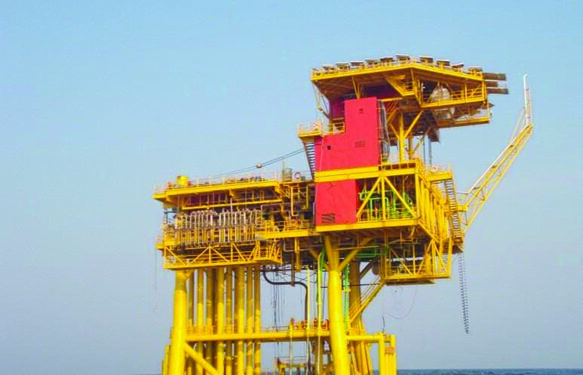CHENNAI, JULY 27
In AtmaNirbhar Bharat or Self-reliant India, higher educational institutions undertake research to help the domestic companies save money and cost. Recently, the ‘Structural Integrity Management System’ (SIMS) was developed by the Offshore Structures Group from the Department of Ocean Engineering, IIT Madras. It has a large database management system, housing crucial information about structural and other design-related data, which can be extracted with a click of a button, saving considerable time and effort for ONGC.
The system will be implemented in ONGC with access to various stakeholders like Institute of Engineering and Ocean Technology (IEOT), offshore Assets, Offshore Engineering Services and Inspection and maintenance and repair teams of ONGC.
- Indian Institute of Technology Madras (IIT Madras) has developed an indigenous lifecycle management system for the Oil and Natural Gas Corporation (ONGC) to reduce the cost of maintenance and rehabilitation of offshore platforms.
- IIT Madras has been at the forefront of developing indigenous technologies and delivering custom solutions for the Industry: Pankaj Kumar, Director (Offshore) ONGC
- More than 330 offshore platforms are producing 70 percent of crude oil and 78 percent of natural gas production of ONGC’s domestic hydrocarbon supply

⇑ Prof V Kamakoti, Director, IIT Madras, handed over the SIMS system to Pankaj Kumar, Director (Offshore), ONGC, at a function recently.
Pankaj Kumar, Director (Offshore) ONGC, who complimented the efforts of IITs in developing such products, said IIT Madras, in particular, has been at the forefront of developing indigenous technologies and delivering custom solutions for the Industry.
ONGC is collaborating with IIT Madras Ocean Engineering Department, which has been providing invaluable contributions in developing high-end technical solutions in the domain of offshore areas. This particular software – SIMS – is an example of ‘Aatmanirbhar Bharat – Digital India’ outcome, in keeping with the vision of Prime Minister and is an excellent effort of Industry-academia collaboration to realize his vision”
ONGC was a leader in adopting newer technologies to increase the efficiency and safety of people and property. The role of R&D becomes vital in this direction as the world is changing fast with destructive changes in many fields. The continued production of oil and gas from mature fields of ONGC will require our assets to last long, beyond their desired lives through technologies.”
‘Structural Integrity Management’ is the implementation of engineering, inspection, maintenance, monitoring and remediation activities required to demonstrate the fitness-for-service of a structure for its intended application throughout its total service life and prevent/mitigate severe or catastrophic health, and safety, environmental, or structural events.
The SIM process provides a proactive approach to monitoring, evaluating and assessing the structural condition and establishing a procedure to validate the fitness-for-service of an offshore structure.
Congratulating the Ocean Engineering Department Researchers and ONGC on development of this system, Prof V Kamakoti, Director, IIT Madras, said, “We are not just an academic institution as our researchers have developed a product. Today, tons and tons of your personal data is going (abroad). IIT Madras contribution is important in keeping ONGC data from going out. This data, if collected in a streamlined manner for some years, can help in the development of indigenous start-ups that can develop Aatma Nirbhar technologies.”
Stating that the system is a very important one, he said along with the oil, it is also drilling data, which is very important. Real-time sensors can enable inspection every second, instead of periodical frequencies. We can also develop AI and ML Tools to predict when inspections would be required.”
The SIMS is a multi-parameter optimization and decision-making system for reducing life cycle costs of inspection and maintenance. ONGC spends a lot of effort and time in underwater inspection and repair and rehabilitation of these aged assets, as these were constructed in the eighties and nineties. A systematic approach is required to decide the timelines based on the risk associated with the system.
The major risk associated with offshore platforms is joint crack due to fatigue and corrosion. This system gives a solution to determining the frequency of health checks and related risks using inspection data, structure characteristics, and information obtained from surveys, among others, and the decision is made and recommended.
Speaking about this system, Prof S Nallayarasu, Head, Department of Ocean Engineering, who headed the Research Team that developed the system, said, “SIMS process provides a proactive approach to monitor, evaluate and assess the structural condition and establish a procedure to validate the fitness-for-service of an offshore structure. It includes the development of database management system for more than 330 platforms, development of Reliability Analysis Scheme for fatigue life of tubular joints and development of a Risk-Based Underwater Inspection Methodology (RBUI).”
More than 330 offshore platforms are producing 70 percent of crude oil and 78 percent of natural gas production of ONGC’s domestic hydrocarbon supply. The platforms operated have been installed with a design life of 25 years. More than 50 per cent of these structures have outlived their design life. These platforms are required to be in operation for an extended period of production of hydrocarbon. Life extension of these platforms is cost effective solution instead of decommissioning these aged assets.”












